History of The Nickel Coin
The history of the nickel coin dates back to the 19th century, when it was first introduced in the United States. Over the years, the nickel coin has featured a variety of designs. Including the Shield nickel, the Liberty Head nickel, the Buffalo and the Jefferson nickels of today.
Today, nickel coins continue to be an essential part of the U.S. modern currency system, providing a low-value denomination for use in everyday transactions.
Let's walk through the history of the nickel coin...
Nickel Three Cent Pieces (1865-1889)
Today, nickel coins in the U.S. are synonymous with five cent pieces, But you may be surprised to learn that wasn't always the case.
America's first nickel coins actually had a face value of three cents. Hoarding of silver coins after the Civil War caused shortages. So in 1865, the U.S. Mint introduced nickel three cent coins as an alternative to silver three cent pieces (known as "trimes").
The denomination was minted in both silver and nickel from 1865-1873. However, the nickel coins were easily recognized from their silver counterparts. Their reverse was similar, with a Roman numeral III for the denomination. But while silver trimes bore a star on their obverse, the obverse of three cent nickel coins depicted Liberty.
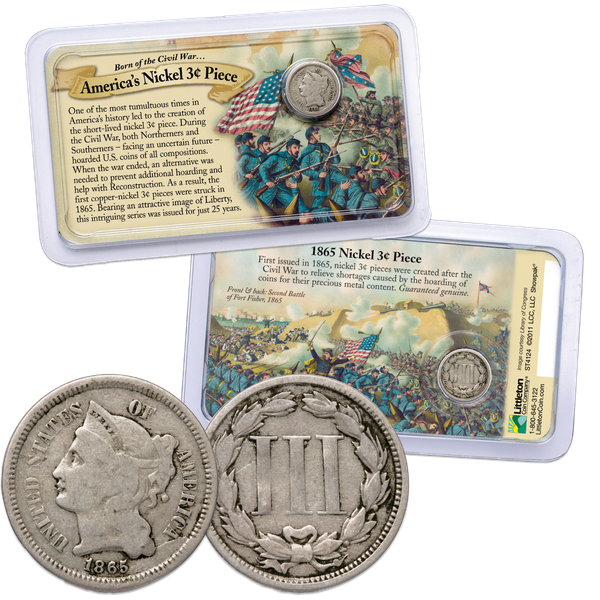
Nickel three cent pieces were minted for a total of 25 years until the three cent denomination was finally retired in 1889.
Shield Nickels, 1866-1883
The history of 5¢ "nickels" begins with the Shield nickel. It was introduced in 1866 because silver half dimes – like all silver coins – were hoarded following the Civil War.
The Shield nickels of 1866-1883 were struck in 25% nickel and 75% copper – the same composition used today. These nickel coins featured a Union Shield on the obverse, which was a symbol of unity commonly used during the Civil War era.
During 1866 and early 1867, the large numeral "5" on the reverse was surrounded by alternating rays and stars. These short-lived Shield nickels "With Rays" were replaced during 1867 by the "Without Rays" variety, which continued for the rest of the series.
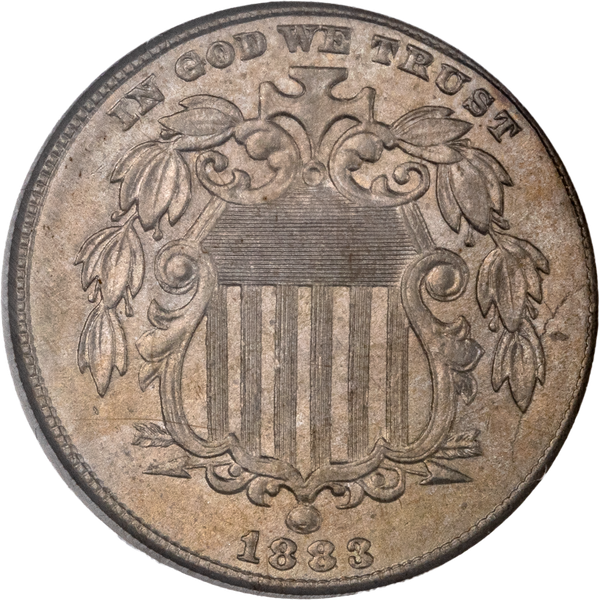
Except for Shield nickels of 1866-1869 and 1882, mintages remained very small compared to later nickel production.
Browse our selection of Shield nickels here.
Liberty Head "V" Nickels, 1883-1913
During the year 1883, the design of America's 5¢ nickels was changed to the now-famous Liberty Head nickel motif by U.S. Mint Chief Engraver Charles Barber. Liberty is seen on the obverse with a coronet inscribed LIBERTY.
These coins are commonly known as "V" nickels because the reverse featured a large Roman numeral V (5) for the denomination.
Some 1883 Liberty Head nickels were gold-plated by individuals who were trying to deceive others by passing them off as $5 gold coins. This was possible because the word "CENTS" was omitted on the reverse side of the nickel coin and the size of the coin was similar to that of Liberty Head $5 gold coins of the time.
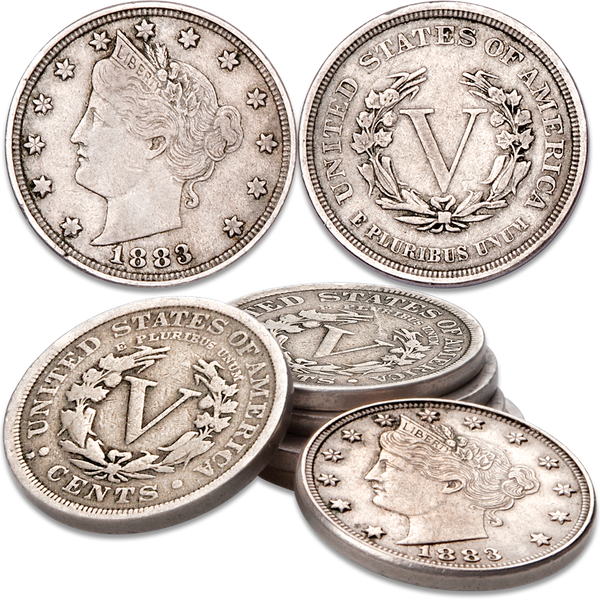
The most infamous of these racketeers was Josh Tatum. A deaf mute, he was caught but never convicted because he apparently never claimed the coins were anything other than nickels. He simply accepted whatever change he received (from 5¢ or $5).
Something had to be done. So after some 5.5 million coins were struck, the U.S. Mint added the word CENTS below the Roman numeral "V" on the reverse of the Liberty "V" nickels.
An equally interesting event occurred at the end of the series, when five unauthorized 1913 Liberty Head nickels were struck by some mint insider (no other 1913 Liberty nickels were produced). These extremely rare "V" nickels are among the most legendary of all U.S. coins.
Browse our selection of Liberty Head "V" nickel coins here.
Buffalo Nickels, 1913-1938
The Buffalo nickel – also known as the Indian Head nickel – showcases an American motif designed by renowned sculptor James Earle Fraser.
During the early 20th century, most circulating U.S. coins received new designs that were highly acclaimed and influenced by President Theodore Roosevelt, who served from 1901-1909. And the nickel was no exception.
Fraser's new design was an instant classic, due in large part to its distinctly American motif. The obverse displays a portrait of a proud Native American chief, while the reverse features an American bison (often called a buffalo).
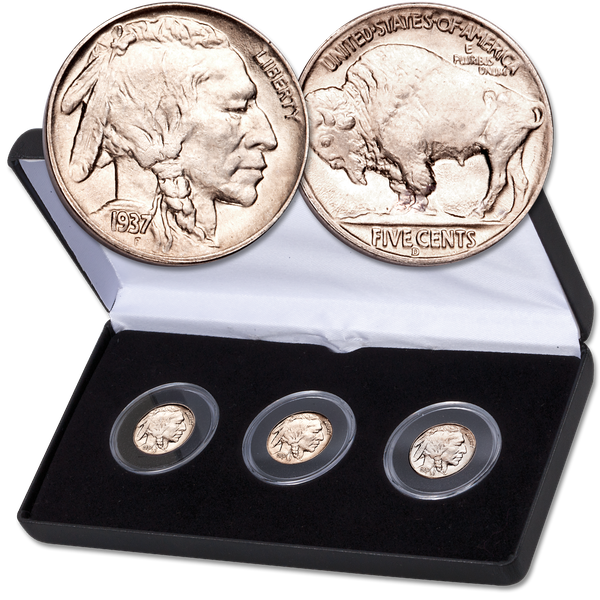
When introduced in 1913, the buffalo stood on a raised mound inscribed with FIVE CENTS (Type 1). But the raised mound caused the inscription to wear off quickly. So the design was changed midway through 1913 to protect the words FIVE CENTS by placing them in a recessed area below the buffalo (Type 2).
These revered U.S. nickel coins were struck until 1938 in very modest quantities compared to modern nickel mintages.
Browse our selection of Buffalo nickel coins here.
Jefferson Nickels, 1938-Present
Thomas Jefferson, author of the Declaration of Independence, is featured on the Jefferson nickel.
In 1938, the design of nickels was changed after 25 years of featuring the Buffalo motif. The new design showcased the profile of Thomas Jefferson, primary author of the Declaration of Independence and 3rd U.S. president who significantly expanded the country with the Louisiana Purchase in 1803.
His Virginia home Monticello was depicted on the reverse.
From mid-1942 to 1945 during World War II, Jefferson nickel coins were produced using a special silver alloy to conserve nickel for the war effort. These silver wartime issues are easily recognized by their larger mint mark, which appears on the reverse above Monticello.
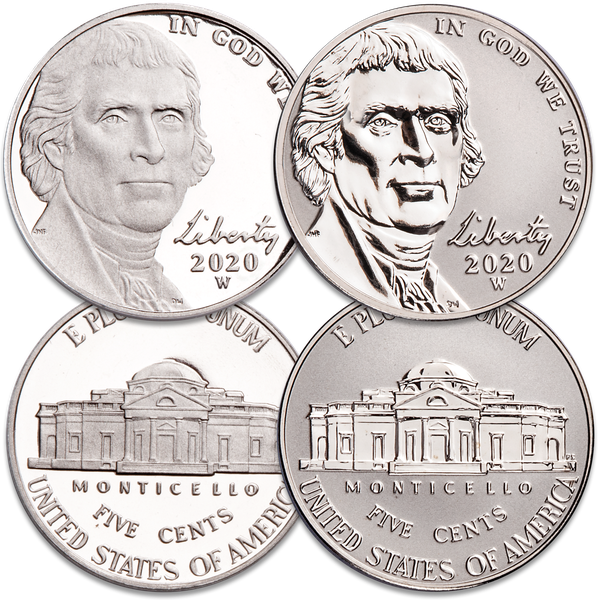
Aside from this, the design remained unchanged for over 65 years. In 2004, special designs were introduced to commemorate the bicentennial of the 1804-1806 Lewis & Clark Expedition – authorized by President Jefferson to explore the vast, newly acquired Louisiana Purchase.
The "Peace Medal" and "Keelboat" reverse designs were minted exclusively in 2004. In 2005, they were followed by the "American Bison" and "Ocean in View" issues – both of which bore a new obverse design showed a close-up portrait of Jefferson.
In 2006, the nickel's design changed yet again. For the obverse, a new forward-facing portrait of Jefferson was introduced. While the reverse changed to once more feature Jefferson's home, Monticello. This design remains in use today.
Browse our selection of Jefferson nickels here.
Interesting Facts About Nickel Coins
Nickel coins have a fascinating history and unique properties that make them stand out in the world of currency.
Here are six interesting facts about nickels:
- Composition: Nickel coins are made from cupro-nickel, a combination of copper and nickel. This alloy gives the coin its distinct silvery appearance and durability.
- Strategic Metal: Nickel is an essential metal that has played a crucial role in various industries, including coin production. Its durability and resistance to corrosion make it a preferred choice for minting coins.
- Three Cent Nickel Coins: The first U.S. coins struck in nickel bore a denomination of three cents, not five. They were introduced in 1865 due to hoarding of silver three-cent pieces (known as "trimes").
- Half Dime: The first five-cent piece was struck in 1792 and known as a half disme (or half dime). The size of the nickel was smaller compared to its current size. The production of the 5¢ nickel coin began in 1866, but the Mint continued to produce the silver half dime until 1873. Both types of five-cent coins were in circulation at the same time.
- Modern Variations: In addition to the traditional nickel, the United States Mint has issued commemorative nickels in recent years. These coins celebrate significant events in American history and feature unique designs.
- Global Significance: Nickel coins are not exclusive to the United States. Many countries around the world, including Canada and Sweden, have their own versions of nickels.
Read more...

